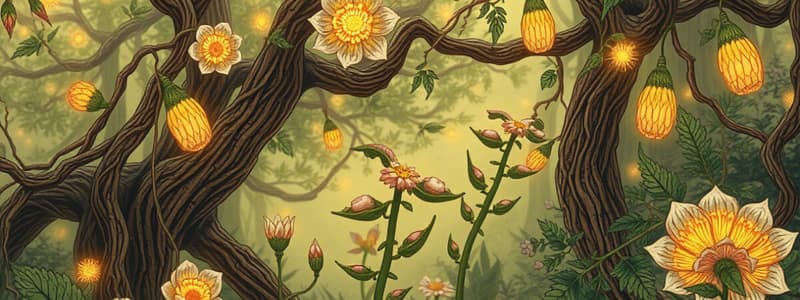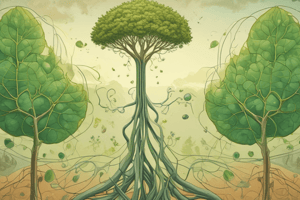Podcast
Questions and Answers
What is CAM in plants?
What is CAM in plants?
Crassulacean acid metabolism
CAM plants open their stomata during the day.
CAM plants open their stomata during the day.
False (B)
Which of the following plants utilize CAM? (Select all that apply)
Which of the following plants utilize CAM? (Select all that apply)
- Cacti (correct)
- Rose
- Pineapples (correct)
- Lily
What factors can affect the rate of photosynthesis?
What factors can affect the rate of photosynthesis?
At what temperature range do enzymes work best during photosynthesis?
At what temperature range do enzymes work best during photosynthesis?
Light intensity does not affect the rate of photosynthesis.
Light intensity does not affect the rate of photosynthesis.
Water is required in the ______ dependent reactions.
Water is required in the ______ dependent reactions.
What happens to photosynthesis at very low or very high temperatures?
What happens to photosynthesis at very low or very high temperatures?
What are autotrophs?
What are autotrophs?
What do heterotrophs need to do to obtain energy?
What do heterotrophs need to do to obtain energy?
What is the energy source for autotrophs?
What is the energy source for autotrophs?
What is the main product of photosynthesis?
What is the main product of photosynthesis?
The main pigment involved in photosynthesis is ______.
The main pigment involved in photosynthesis is ______.
Chlorophyll reflects green light.
Chlorophyll reflects green light.
Which of the following is a chemical compound used to store energy in cells?
Which of the following is a chemical compound used to store energy in cells?
ADP is considered to be ______ in energy.
ADP is considered to be ______ in energy.
Match the following components with their functions in photosynthesis:
Match the following components with their functions in photosynthesis:
What gas is released as a byproduct of photosynthesis?
What gas is released as a byproduct of photosynthesis?
What happens to ADP when a phosphate group is added?
What happens to ADP when a phosphate group is added?
The Calvin Cycle takes place in the thylakoids.
The Calvin Cycle takes place in the thylakoids.
What is NADPH used for in photosynthesis?
What is NADPH used for in photosynthesis?
Photosynthesis utilizes the equation ______.
Photosynthesis utilizes the equation ______.
What are the two main types of chlorophyll?
What are the two main types of chlorophyll?
What is the main function of the stomata in leaves?
What is the main function of the stomata in leaves?
What do C4 plants have that allows them to maintain photosynthesis while conserving water?
What do C4 plants have that allows them to maintain photosynthesis while conserving water?
Flashcards are hidden until you start studying
Study Notes
Autotrophs and Heterotrophs
- Autotrophs produce their own food using sunlight, primarily converting it into glucose.
- Examples of autotrophs include green plants, certain bacteria, and some protists.
- Heterotrophs, including all animals and fungi, cannot make their own food; they must consume other organisms.
- Photosynthesis is the process by which plants convert sunlight into chemical energy stored in glucose, with oxygen released as a by-product.
Chemical Energy and ATP
- Living cells store energy in chemical compounds, primarily ATP (Adenosine Triphosphate) and ADP (Adenosine Diphosphate).
- ATP is an energy-rich molecule, while ADP is considered energy-poor.
- ATP consists of adenine, ribose (a sugar), and three phosphate groups; removing a phosphate releases energy for cellular activities.
- Cells regenerate ATP continuously, with muscle cells producing up to 10 million ATP molecules per second.
Overview of Photosynthesis
- Photosynthesis converts water and carbon dioxide into high-energy sugar molecules and oxygen using sunlight.
- The general equation for photosynthesis: 6CO2 + 6H2O + sunlight → C6H12O6 + 6O2.
- Plants absorb carbon dioxide from the atmosphere and water from the soil to drive this process.
Light and Pigments
- Light energy from the sun, along with chlorophyll, is essential for photosynthesis.
- The electromagnetic spectrum includes visible light, which drives photosynthesis; colors include red, orange, yellow, green, blue, indigo, and violet.
- Chlorophyll absorbs most visible light wavelengths except green, making plants appear green.
Photosynthetic Membranes
- Leaves are the primary site for photosynthesis, housing approximately half a million chloroplasts per square millimeter.
- The leaf structure includes cuticles to prevent water loss, mesophyll cells for photosynthesis, stomata for gas exchange, and vascular bundles for nutrient transport.
- Chloroplasts consist of outer membranes, thylakoids (where light reactions occur), and stroma (where the Calvin cycle occurs).
Electron Carriers
- High-energy electrons generated by chlorophyll in sunlight-driven reactions need transport via electron carriers.
- NADP+ serves as a key electron carrier, converting to NADPH by accepting high-energy electrons and a hydrogen ion.
- NADPH is utilized in the Calvin cycle to synthesize glucose.
Stages of Photosynthesis
- Photosynthesis occurs in two main stages: Light Dependent Reactions and Light Independent Reactions (Calvin Cycle).
- Light Dependent Reactions occur in thylakoids, creating ATP and NADPH, while the Calvin Cycle takes place in the stroma to produce glucose.
The Light Dependent Reactions
- Photosystems I and II are integral to the light reactions, absorbing light and energizing electrons.
- Water molecules are split into electrons, hydrogen ions, and oxygen (waste product) to replenish lost electrons.
- ATP synthase uses proton flow to generate ATP during these reactions.
The Calvin Cycle
- Occurs in the stroma, utilizing carbon dioxide, ATP, and NADPH to produce glucose through a series of reactions.
- Involves carbon fixation using RuBP and converting PGA to PGAL, with PGAL either forming glucose or regenerating RuBP.
Alternative Pathways in Photosynthesis
- Plants face dehydration risks; stomata must open for carbon intake, leading to water loss.
- C4 plants (e.g., corn, sugarcane) convert carbon dioxide to oxaloacetic acid for later use, maintaining photosynthesis while conserving water.
- CAM plants (e.g., cacti, pineapples) absorb carbon dioxide at night and close stomata during the day to mitigate water loss.
Factors Affecting the Rate of Photosynthesis
- Water shortages can hinder photosynthesis; plants have a waxy cuticle to reduce water loss.
- Optimal temperature range for photosynthesis is between 0°C and 35°C; extreme temperatures can damage enzymes or halt the process.
- Increasing light intensity enhances photosynthesis rates, reflecting its dependency on sunlight.
Studying That Suits You
Use AI to generate personalized quizzes and flashcards to suit your learning preferences.




